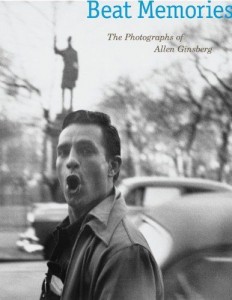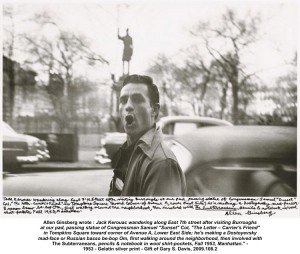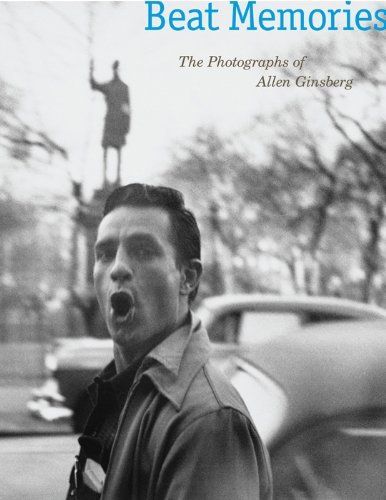 Beat Memories: The Photographs of Allen Ginsberg
Beat Memories: The Photographs of Allen Ginsberg
Edited by Sarah Greenough
Prestel USA
144 pages (illustrations), $49.95
“THE MOMENTS when notoriety began to transform” the lives of Allen Ginsberg’s friends were the moments—among many others—that Ginsberg chose to capture in this fascinating new addition to our knowledge of the Beat Generation. Earl A. Powell III, director of the National Gallery of Art, wrote the foreword to Beat Memories, the catalog for an exhibit at the National Gallery earlier this year (May 2 to Sept. 6). But they’re much more than just images: each is captioned by what in many cases is a miniature diary entry.
Sarah Greenough, who conceived and organized this catalog, outlines the beginning of Ginsberg’s photographic career, in 1953, with a second-hand Kodak Retina, although as a young teenager he’d used a box camera to document his mother’s life as a patient at the Greystone Park Psychiatric Hospital in New Jersey. His friendships with pre-eminent photographers Berenice Abbott and Robert Frank were instrumental in his work. On Abbott’s recommendation, Ginsberg began to write captions onto photographic paper, revising and adding to the text every time a picture was reprinted. Despite his somewhat choppy penmanship, all the captions are quite easy to decipher, and are often wittily written, usually with an eye for literary and social history. There’s a photograph of the ravaged Jack Kerouac, and this one run-on sentence suits the scene. “Jack Kerouac the last time he visited my apartment 704 East 5th Street N.Y.C., he looked by then like his late father, red-faced corpulent W. C. Fields shivering with mortal horror, grimacing on D.M.T. I’d brought back from visiting Timothy Leary at Millbrook Psychiatric Community, Fall 1964.”
A smiling Carl Solomon in a shirt and tie, underwear and socks, is shown in his Prince Street apartment, “several years after we were locked up together” at the New York Psychiatric Institute, where Solomon was subjected to shock treatment. Solomon went on to work at Ace Books, owned by his uncle, where he apparently gave Kerouac an advance on his “On the Road” stories, and edited the first edition of William Burroughs’ Junkie. It was published in 1953 under the pseudonym of William Lee.
 The meeting of Ginsberg and his longtime lover, the bisexual Peter Orlovsky, has been recounted in multiple sources, recently by Bill Morgan in his The Typewriter Is Holy: The Complete, Uncensored History of the Beat Generation (2010). Morgan, who was Ginsberg’s bibliographer and archivist, stated that Ginsberg and Orlovsky met in the mid-1950’s when the former fell into a friendship with painter Robert LaVigne, in whose studio Ginsberg “saw a painting [Nude with Onions] of a stunningly attractive nude young man.” By chance, the model, Orlovsky (who had a girlfriend at that time), walked in. Morgan wrote that Orlovsky was “sweet and sincere, and the sanest of the family.”
The meeting of Ginsberg and his longtime lover, the bisexual Peter Orlovsky, has been recounted in multiple sources, recently by Bill Morgan in his The Typewriter Is Holy: The Complete, Uncensored History of the Beat Generation (2010). Morgan, who was Ginsberg’s bibliographer and archivist, stated that Ginsberg and Orlovsky met in the mid-1950’s when the former fell into a friendship with painter Robert LaVigne, in whose studio Ginsberg “saw a painting [Nude with Onions] of a stunningly attractive nude young man.” By chance, the model, Orlovsky (who had a girlfriend at that time), walked in. Morgan wrote that Orlovsky was “sweet and sincere, and the sanest of the family.”
One of Ginsberg’s more shocking images is a family portrait, in the style of Diane Arbus, of Peter Orlovsky, one of his three brothers, Lafcadio, his sister Marie, and mother. The disturbed condition of each individual is almost palpable. Ginsberg wrote a lengthy caption, concluding: “They needed a taxi [from their Long Island apartment]for any heavy shopping with monthly Social Service Indemnity checks at a supermarket a mile away.” Peter Orlovsky died on May 30, 2010, and his obituary in The New York Times quotes his guardian as saying that “he could be certain only that Mr. Orlovsky is survived by Lafcadio.” (The very thorough website, “The Allen Ginsberg Project,” at ginsbergblog.blogspot.com, contains other Ginsberg images of the Orlovsky family.)
The last photograph in the book, taken in 1997, was of Robert Frank and Peter Orlovsky. The afterword of Beat Memories is a 1991 interview with San Francisco journalist Thomas Gladysz, in which Ginsberg offers insightful comments about the interconnectedness of art, friends, and history. The following gem is vintage Ginsberg: “The poignancy of a photograph comes from looking back to a fleeting moment in a floating world.”






